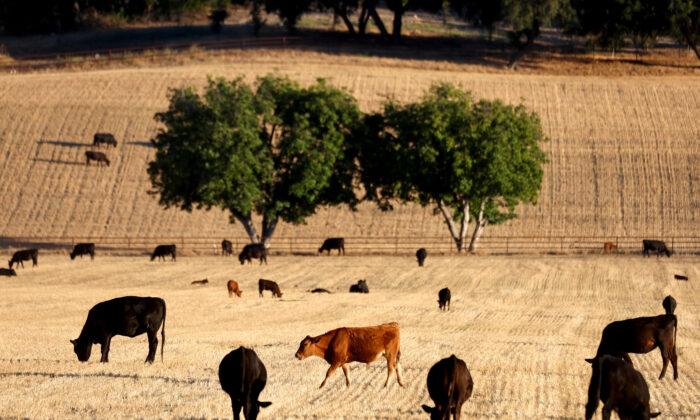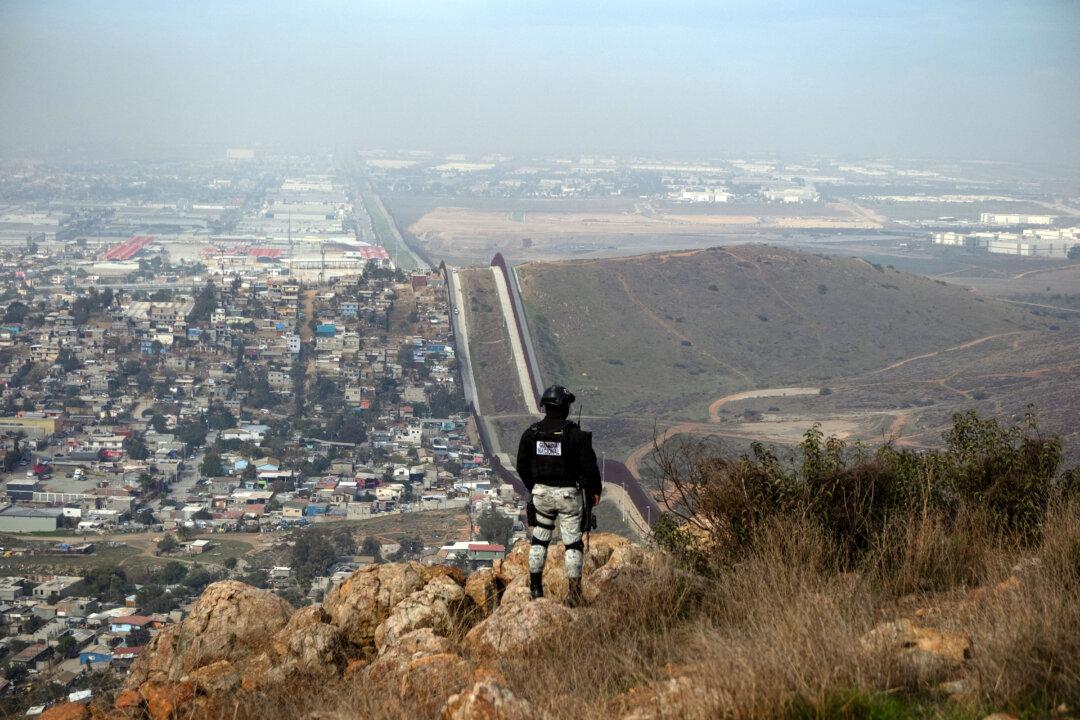Kansas cattle rancher Kyle Hemmert watches the decline of cattle farmers in Ireland and the Netherlands and sees the future for himself and his fellow ranchers.
“What’s happening in the beef industry is the same thing that’s happened in the sheep industry,” Mr. Hemmert told The Epoch Times. “America peaked at 51 million sheep; today, we have less than 5 million.
“I’m seeing empty pastures in my area,” he said. “People said ‘to hell with it.’”
Bill Bullard, CEO of R-CALF USA, spoke to The Epoch Times about the issue.
“The cattle industry is the last frontier; it’s the last segment of the livestock industry that still has a sufficient level of competition to sustain independent producers,” Mr. Bullard said.
With about 5,000 members, R-CALF represents independent cattle ranchers and is fighting to preserve their independence. But they are facing off against a group of only four major buyers for their cows, new federal initiatives that favor the large packing companies, and climate activism that claims cows emit too many greenhouse gasses and must have their numbers reduced.
“The model that they have applied, first to the poultry industry and now to the hog industry, has been extremely successful for the multinational meat packers that want to vertically integrate the entire industry,” Mr. Bullard said, “and that vertical integration kills competition.”
The cash markets that once existed between buyers and sellers in these industries are largely gone, with farmers becoming either employees or working under contract to packing companies.
“Now, if you want to produce hogs, you do so by invitation from an integrator because you have a contract to produce hogs,” Mr. Bullard said. “They’re applying that, unfortunately, very successful model to the cattle industry right now.”
Rep. Harriet Hageman (R-Wyo.) has also commented on the issue.
“That’s the example of vertical integration that’s already happened in large part with our pork producers and our poultry producers,” Ms. Hageman told The Epoch Times. “And they want to do exactly the same thing with our ranches. They want to basically make our ranchers nothing but paid employees, and the ranches and the real property would be owned by the big packers.”
South Dakota rancher Brett Kenzy told The Epoch Times that the American rancher is a remnant of a “self-reliant, independent, entrepreneurial, hardworking, religious, multigenerational person that used to be very commonplace.”
The Miracle of Cows
“The miracle of the cow is the fact that she has four chambers in her stomach, and she can eat grass, which is carbohydrate, and create protein,” Mr. Kenzy said. “They’re the only animal on earth that can do it that efficiently.“Beef is the most well-balanced source for human beings in terms of vitamins, minerals and protein,” he said, “but that four-chambered stomach, as they’re running it through, they belch methane.”
These methane emissions have put cows directly in the crosshairs of climate activists. Many of the corporations that control food markets have joined net-zero clubs like Climate Action 100+, which pledge to slash greenhouse gas emissions for themselves and their suppliers.
“Rather than just killing off the cattle all at once, this is going to be a controlled implosion of the beef industry,” Mr. Kenzy said. “I think the end goal is ultimately controlling the food supply.”
Cattle ranchers “went through a period from 2015 to 2021 where they could not recover their cost of production,” Mr. Bullard said. “We’ve seen segments of our industry literally drop like flies.”
“Just four decades ago, we had about 1.3 million independent cattle farmers and ranchers that were maintaining mother cow herds and raising calves each year,” Mr. Bullard said. “Due to economic costs, price squeezes, a lack of profitability, and a lack of competition [among buyers], we wiped out 43 percent of them.”
“The fact that cattle producers were receiving seriously depressed prices for the cattle, at the same time that consumers were paying super inflated prices for beef in the grocery store, that prompted us to file a national class action suit against the largest four packers that control 85 percent of the fed cattle market,” Mr. Bullard said.
It is only recently that these price increases made their way through to the ranchers that remained in business.
“This year is going to be profitable for the cow-calf man, but for the last six, seven years there has not been profit,” Mr. Hemmert said. “When there’s not profit, it signals to the industry to cut back, quit producing, and there’s been a lot of cow herds that have been sold.”
The Problem With Cows
The United Nations Food and Agricultural Organization asserts that emissions from livestock farms are about seven gigatons of carbon dioxide per year, or about 15 percent of all human-induced greenhouse gas emissions (pdf).“Beef and cattle milk production account for the majority of emissions, respectively contributing 41 and 20 percent of the sector’s emissions,” the U.N. states.
The solution proposed by climate activists is to reduce the production of beef, with a target of 30 percent reduction in cattle herds. Countries like Ireland and the Netherlands have already attempted to introduce laws and regulations to cut herds.
In May, the European Union green-lit a Dutch plan to spend $1.6 billion to purchase or seize Dutch farmers’ land. This policy led to mass farmer protests under slogans like “No Farmers, No Food.”
In the United States, however, targets to reduce livestock emissions are being set not by government fiat but by a handful of corporate food producers.
Tyson is one of the four dominant packing companies in the beef industry; the other three are Minnesota-based Cargill, and Brazilian-based JBS Foods and Marfrig. Together these four companies process about 85 percent of all beef in the United States.
And it is not just the packing oligopoly that is expanding its control into the ranching industry. A similar consolidation and vertical integration is happening within global grocery chains as well.
‘Rich Countries Must Cut Meat Consumption’
The North American Meat Institute, whose members include meat packing companies that account for more than 95 percent of America’s meat and poultry products, launched its Protein PACT Academic Advisory Council in June, which works with its members “in setting greenhouse gas reduction targets to be approved by the Science Based Targets initiative.”The SBTi, in partnership with organizations like the United Nations Global Compact and the World Wildlife Fund, pledges to “lead the way to a zero-carbon economy, boost innovation and drive sustainable growth by setting ambitious, science-based emissions reduction targets.” Calling itself the “global body enabling businesses to set emissions reduction targets in line with science,” the SBTi states that “companies in the forest, land and agriculture sectors will reduce at least 72% of emissions by no later than 2050.”
Tyson foods stated in its 2021 Sustainability Report that it had a “Science Based Target” of achieving a 30 percent reduction in greenhouse gas emissions by 2030, and that addressing beef production would be key.
As cows become a prime target for climate activists, it is perhaps not coincidental that cattle ranchers are also the last livestock farmers who have not already been absorbed by global food conglomerates.
“Cattle is the single largest segment of American agriculture; it sets itself apart from the hog and poultry industries,” Mr. Bullard said. “The hog and poultry industry are primarily controlled by multinational meatpacking conglomerates, and they have the ability to defend their interests, unlike the disaggregated independent family farmers and ranchers scattered across the country.
Global Roundtable for Sustainable Beef
Like with other segments of the world’s economy, the environmental social and governance (ESG) movement has made its way into food production as well. One of the key organizations in this effort is the Global Roundtable for Sustainable Beef (GRSB).The GRSB is an international organization with representatives from 24 countries, whose mission is “the advancement of sustainability in the global beef value chain.” Its members include three of the four dominant meat packers: Tyson Foods, JBS, and Cargill.
In 2021, the GRSB announced its commitment to “reduce the net global warming impact of beef 30% by 2030 through global sustainability goals.”
“The Global Roundtable for Sustainable Beef is perpetuating this globalism, where the standards are being set, not in the United States, but globally,” Mr. Bullard said. “They are dictating standards to producers, and they are able to enforce those standards by limiting access to the marketplace because GRSB consists of the world’s largest meat packers.
A Highly Segmented Industry
There are three stages to cattle production, which are often conducted by separate farms, and which have made the industry more difficult to vertically integrate. The first, called the cow-calf producer, maintains a mother cow herd and typically produces one calf each year per mother cow.The second stage is the background stage, where calves from about six months old are fed a growing ration until they are about 1 year old and weigh about 900 pounds. The third stage are feedlots, where cows are fattened for slaughter, generally by grazing.
“We’re a highly segmented industry,” Mr. Kenzy said. “That’s why we’ve been so hard to capture.”
In the past, the stages of raising cattle featured arms-length transactions in which prices were set by supply and demand, as well as the quality of the ranchers’ cattle.
USDA Interfering
The Biden administration’s actions regarding consolidation of the beef industry have been mixed.On the one hand, the U.S. Department of Agriculture (USDA) announced a $1 billion program to fund new processing facilities, including a $962,954 grant to Benson & Turner Foods Inc. to build a cattle and hog processing plant on the White Earth Reservation in Minnesota.
The USDA claims this is for the purpose of tracking diseases, but many ranchers say it will be a prohibitive expense, particularly for smaller farmers.
“The driving force behind it is they want it for exports and they want it to benefit the multinational meat packers,” Mr. Bullard said. “If there’s a disease outbreak in a particular region but they can identify cattle not from that region, they’re able to continue trade uninterrupted, so there’s significant value.
“However, the meat packers don’t want to pay [ranchers] for the added cost of this kind of a program, so they convinced the government to require this to be a mandatory program” that ranchers must pay for, he said.
Others expressed concern that the RFID system will allow the packing conglomerates to impose whatever criteria they come up with on ranchers.
“It’s a way to regulate the production of beef in the name of sustainability,” Mr. Kenzy said, “basically registering all your cattle with the government.
He added that the Global Roundtable will ultimately tell ranchers how to graze, breed, and feed their cattle, rather than the market.
“This really isn’t about traceability or identification,” Ms. Hageman said. “We have a very robust identification and traceability system already in effect and working in the United States, and it’s worked for a long, long time.
“This is another form of surveillance,” she said, “and as we’ve seen by the federal government over the last couple of years, our government really likes to surveil the citizens of this country.
Antitrust Laws Unenforced
Meanwhile, there appears to be little interest within the Biden administration in enforcing antitrust laws in the animal agriculture industry. A relevant law is the 1921 Packers and Stockyards Act, which was written “to assure fair competition and fair trade practices, to safeguard farmers and ranchers, ... to protect consumers, ... and to protect members of the livestock, meat, and poultry industries from unfair, deceptive, unjustly discriminatory and monopolistic practices,” the USDA states.“Many people in the USDA abandoned their core mission, which is really protecting our independent producers and our livestock producers, and they have aligned themselves with big business,” Ms. Hageman said.
“We don’t want a monopoly when it comes to food supply, and the fact is that the United States produces the healthiest, highest quality beef of any country in the world,” she said. “You don’t hear about very many instances where there is a problem, and in fact the instances that you do hear about are typically in the processing end of it, not the cattle production end of it.
“Our cattle producers run their operations very well; they take excellent care of their land because they’re dependent on it to make a living,” she said. “They are some of the very best conservationists that there are, in terms of protecting these resources and open spaces.”
Mr. Hemmert, the Kansas cattle rancher, said ranchers can produce more if given the opportunity to be profitable.
“But if you’re not profitable, you’re not going to produce, and your banker is not going to let you,” he said.
Mr. Kenzy spoke of past efforts by the government to decimate a food supply.
“In the 1800s, they killed all the buffalo off in the northern plains, and they did that to eradicate the ability of the Indians to sustain themselves,” Mr. Kenzy said. “And this war on beef, it looks to me like it’s much the same thing.”
The Epoch Times contacted Walmart and Tyson Foods for comment. Walmart did not respond; Tyson food directed us to the reports referenced in this article.







